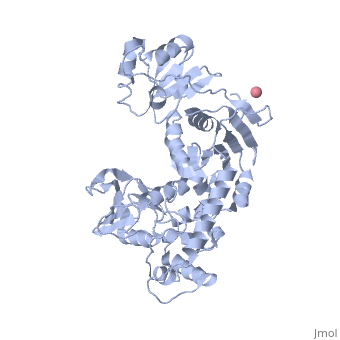3hjh
From Proteopedia
A rigid N-terminal clamp restrains the motor domains of the bacterial transcription-repair coupling factor
Structural highlights
FunctionMFD_ECOLI Couples transcription and DNA repair by recognizing RNA polymerase (RNAP) stalled at DNA lesions. Mediates ATP-dependent release of RNAP and its truncated transcript from the DNA, and recruitment of nucleotide excision repair machinery to the damaged site. Can also dissociate RNAP that is blocked by low concentration of nucleoside triphosphates or by physical obstruction, such as bound proteins. In addition, can rescue arrested complexes by promoting forward translocation. Has ATPase activity, which is required for removal of stalled RNAP, but seems to lack helicase activity. May act through a translocase activity that rewinds upstream DNA, leading either to translocation or to release of RNAP when the enzyme active site can not continue elongation.[1] [2] [3] [4] [5] Evolutionary ConservationCheck, as determined by ConSurfDB. You may read the explanation of the method and the full data available from ConSurf. Publication Abstract from PubMedMotor proteins that translocate on nucleic acids are key players in gene expression and maintenance. While the function of these proteins is diverse, they are driven by highly conserved core motor domains. In transcription-coupled DNA repair, motor activity serves to remove RNA polymerase stalled on damaged DNA, making the lesion accessible for repair. Structural and biochemical data on the bacterial transcription-repair coupling factor Mfd suggest that this enzyme undergoes large conformational changes from a dormant state to an active state upon substrate binding. Mfd can be functionally dissected into an N-terminal part instrumental in recruiting DNA repair proteins (domains 1-3, MfdN), and a C-terminal part harboring motor activity (domains 4-7, MfdC). We show that isolated MfdC has elevated ATPase and motor activities compared to the full length protein. While MfdN has large effects on MfdC activity and thermostability in cis, these effects are not observed in trans. The structure of MfdN is independent of interactions with MfdC, implying that MfdN acts as a clamp that restrains motions of the motor domains in the dormant state. We conclude that releasing MfdN:MfdC interactions serves as a central molecular switch that upregulates Mfd functions during transcription-coupled DNA repair. An N-terminal clamp restrains the motor domains of the bacterial transcription-repair coupling factor Mfd.,Murphy MN, Gong P, Ralto K, Manelyte L, Savery NJ, Theis K Nucleic Acids Res. 2009 Oct;37(18):6042-53. Epub 2009 Aug 21. PMID:19700770[6] From MEDLINE®/PubMed®, a database of the U.S. National Library of Medicine. See AlsoReferences
| ||||||||||||||||||||


